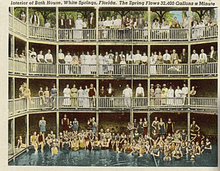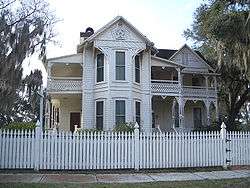White Springs, Florida
For the protected area in Florida known as White Springs see Gar Pond
| White Springs, Florida | |
|---|---|
| Town | |
|
White Springs Town Hall and Police Department | |
 Location in Hamilton County and the state of Florida | |
| Coordinates: 30°19′54″N 82°45′22″W / 30.33167°N 82.75611°WCoordinates: 30°19′54″N 82°45′22″W / 30.33167°N 82.75611°W | |
| Country |
|
| State |
|
| County | Hamilton |
| Incorporated | 1885 |
| Area | |
| • Total | 1.8 sq mi (4.8 km2) |
| • Land | 1.8 sq mi (4.8 km2) |
| • Water | 0 sq mi (0 km2) |
| Elevation | 112 ft (34 m) |
| Population (2000) | |
| • Total | 819 |
| • Density | 455/sq mi (170.6/km2) |
| Time zone | Eastern (EST) (UTC-5) |
| • Summer (DST) | EDT (UTC-4) |
| ZIP code | 32096 |
| Area code(s) | 386 |
| FIPS code | 12-77400[1] |
| GNIS feature ID | 0293230[2] |
| Website | http://www.whitesprings.org/ |
White Springs is a town in Hamilton County, Florida, on the Suwannee River. The population was 819 at the 2000 census. According to the U.S. Census Bureau's 2004 estimates, the town had a population of 828. Home of the annual Florida Folk Festival, it is a tourist destination noted for historic charm, antique shops, and river recreation.
History
The Suwannee River was once the boundary between the Timucuan tribe to the east and Apalachee tribe to the west. When Spanish explorers visited the area in the 1530s, it was inhabited by the former, who believed its springs possessed healing powers.[3] The Indians considered the springs as a sacred healing ground. Any tribe member could bathe and drink the mineral waters without fear of being attacked.[4] The spring water flows through rocks embedded with sulfur crystals and acquires the "rotten egg" smell. The settlement was incorporated in 1831 as Jackson Springs by businessmen Joseph Bryant, James T. Hooker, his brother William B. Hooker, John Lee, and James D. Prevatt. In addition to the spring, they planned to build a ferry across the Suwannee River.[3]
Bryant & Elizabeth Sheffield bought tracts for a cotton plantation in 1835, and took over the ferry operation the following year. Mr. Sheffield drank the mineral waters and touted their ability to cure nervousness, kidney troubles, and rheumatism, among other problems. They constructed a hotel and spring house from logs. The spring called Upper Mineral Springs was very popular and became Florida's first tourist attraction.[3]
During the American Civil War, some Confederate soldiers found refuge in the town from Union troops. The family of future governor Napoleon Bonaparte Broward, whose Jacksonville farm was burned by Union forces, moved to a nearby farm which they named Rebel’s Refuge.[3] At some point, the springs were renamed White Sulphur Springs. Following the civil war, the tourist business slowly returned. In 1882, the Georgia merchants Wight and Powell purchased the property and platted city lots. They sold parcels to other retailers to open businesses catering to plantations and resorts around the spring. Crowds of health seekers arrived, first by stagecoach and then railroad. White Springs was incorporated in 1885. Hotels and boarding houses popped up; a cotton gin attracted buyers and sellers; and fashionable clothing and hats were offered for sale. Leisure activities included ballroom dancing, lawn tennis, and skating.[3]

In 1903, the spring was enclosed by concrete and coquina walls that included multiple water gates and galleries to prevent water intrusion from river flooding. A four-story wooden bathhouse was constructed around the spring.[5] The structure was designed by the Jacksonville architectural firm McClure & Holmes for owner Minnie Mosher Jackson, and included doctors' offices for patient examination and treatment, dressing rooms, space for concessions, and an elevator.[4] At the time, water flow was calculated at 32,400 gallons per minute, or nearly 47 million gallons per day.[6]
During the 1930s, mineral springs fell out of favor and the town began to fade. In 1950, the Stephen Foster Memorial Museum opened to commemorate songwriter Stephen Foster, composer of the world-renowned song of the Suwannee River, “Old Folks at Home.” The museum is surrounded by formal gardens which extend to the banks of the Suwannee River. A carillon containing the world’s largest set of tubular bells, [7] opened in 1957 and plays Foster's songs throughout the day. The facility is a Florida State Park.
Present
Through the 1980s, water flow at the spring declined to the point when it ceased flowing in 1990. The mayor of White Springs, Dr. Helen Miller, is vice chairman of Florida Leaders Organized for Water (FLOW), a group which proposed the Floridan Aquifer Sustainability Act of 2013. The legislation seeks to restore the Floridan aquifer to 1980 levels.[8]
Today, many of the original Victorian buildings survive, particularly within the White Springs Historic District, established in 1997 by the National Register of Historic Places.[3]
The town and state park are the site of the annual Florida Folk Festival, a four-day celebration of traditional Florida food, arts, and music. The event, first held in 1953, is one of the oldest continuous folk festivals in the United States.[9]
Geography
White Springs is located at 30°19′54″N 82°45′22″W / 30.33167°N 82.75611°W (30.331647, -82.756008).[10]
According to the United States Census Bureau, the town has a total area of 1.8 square miles (4.7 km2), all of it land. White Springs is on the Suwannee River. The town is crossed by U.S. Route 41 (SR 25 and 100) and SR 136.
Demographics
| Historical population | |||
|---|---|---|---|
| Census | Pop. | %± | |
| 1890 | 543 | — | |
| 1900 | 690 | 27.1% | |
| 1910 | 1,177 | 70.6% | |
| 1920 | 984 | −16.4% | |
| 1930 | 618 | −37.2% | |
| 1940 | 600 | −2.9% | |
| 1950 | 700 | 16.7% | |
| 1960 | 633 | −9.6% | |
| 1970 | 767 | 21.2% | |
| 1980 | 781 | 1.8% | |
| 1990 | 704 | −9.9% | |
| 2000 | 819 | 16.3% | |
| 2010 | 777 | −5.1% | |
| Est. 2014 | 769 | [11] | −1.0% |
As of the census[1] of 2000, there were 819 people, 340 households, and 227 families residing in the town. The population density was 446.0 people per square mile (171.9/km²). There were 393 housing units at an average density of 214.0 per square mile (82.5/km²). The racial makeup of the town was 36.75% White, 62.15% African American, 0.37% Native American, and 0.73% from two or more races. Hispanic or Latino of any race were 0.37% of the population.
There were 340 households out of which 33.5% had children under the age of 18 living with them, 36.2% were married couples living together, 26.2% had a female householder with no husband present, and 33.2% were non-families. 29.7% of all households were made up of individuals and 12.1% had someone living alone who was 65 years of age or older. The average household size was 2.41 and the average family size was 2.93.
In the town the population was spread out with 30.3% under the age of 18, 10.4% from 18 to 24, 26.4% from 25 to 44, 20.8% from 45 to 64, and 12.2% who were 65 years of age or older. The median age was 32 years. For every 100 females there were 85.3 males. For every 100 females age 18 and over, there were 75.7 males.
The median income for a household in the town was $24,861, and the median income for a family was $32,115. Males had a median income of $31,953 versus $21,250 for females. The per capita income for the town was $15,555. About 20.0% of families and 22.6% of the population were below the poverty line, including 22.3% of those under age 18 and 26.6% of those age 65 or over.


See also
References
- 1 2 "American FactFinder". United States Census Bureau. Retrieved 2008-01-31.
- ↑ "US Board on Geographic Names". United States Geological Survey. 2007-10-25. Retrieved 2008-01-31.
- 1 2 3 4 5 6 "History of the Town of White Springs". City of White Springs, Florida. Retrieved 18 January 2013.
- 1 2 "History of White Springs Florida". Small Town Gems. Retrieved 18 January 2013.
- ↑ "Interior of Bath House, White Springs, Florida.". 191?. State of Florida, Division of Library and Information Services. Retrieved 18 January 2013.
- ↑ "Bath House, Spring Street, White Springs, Hamilton County, FL". Historic American Buildings Survey (Library of Congress). Historic Map Works. Retrieved 18 January 2013.
- ↑ "Stephen Foster State Folk Culture Center" Yahoo Travel
- ↑ Ritchie, Bruce (2012-10-29). "White Springs mayor leads support for water legislation that seeks to protect springs". Florida Current. Retrieved 21 January 2013.
- ↑ "About the Florida Folk Festival". Florida Folklife Collection. Division of Library & Information Services. Retrieved 18 January 2013.
- ↑ "US Gazetteer files: 2010, 2000, and 1990". United States Census Bureau. 2011-02-12. Retrieved 2011-04-23.
- ↑ "Annual Estimates of the Resident Population for Incorporated Places: April 1, 2010 to July 1, 2014". Retrieved June 4, 2015.
- ↑ "Census of Population and Housing". Census.gov. Retrieved June 4, 2015.
External links
- White Springs homepage
- Florida Folk Festival
- Stephen Foster Folk Culture Center
- Homepage of the Florida Folklife Collection (housed at the State Archives of Florida) which includes thousands of images and recordings of the Florida Folk Festival; held annually in White Springs, Florida
| |||||||||||||||||
